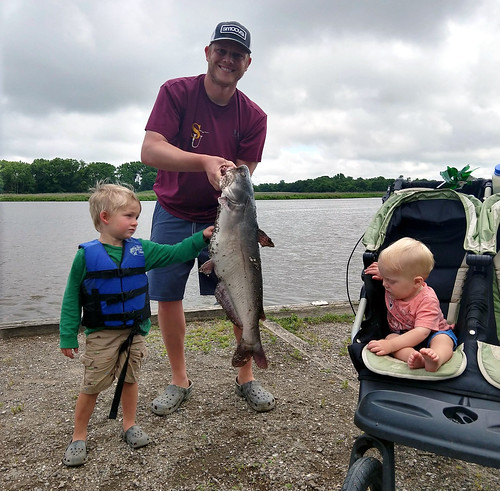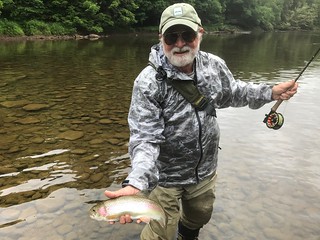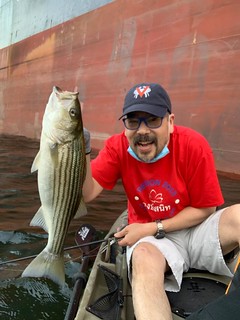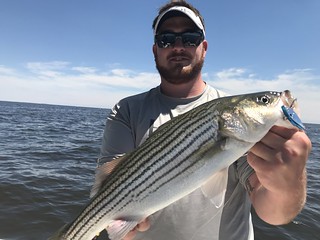Maryland Fishing Report – June 24

Bryan Brainer spent a fun day with his two young sons fishing for blue catfish in the Chester River. Photo courtesy of Bryan Brainer
Many dads, daughters, sons, and moms spent a special Father’s Day enjoying time together in that special setting that fishing provides.
The Maryland Department of Natural Resources offers a license-free fishing day July 4 — an opportunity to explore Maryland’s diverse and unique fishing experiences without needing a fishing license, trout stamp, or registration.
As we enter Maryland’s warmest months, the department’s online striped bass fishing advisory forecast provides a seven-day outlook to help anglers reduce striped bass mortality during the summer fishing season.
Expect sunny skies and warm temperatures all week. Chesapeake Bay surface water temperatures have jumped to the upper 70s. These warming waters and corresponding low oxygen areas are appearing from Swan Point down to the mouth of the Potomac River. The eastern side of the bay will have unsuitable oxygen conditions for fish in waters deeper than 25 feet.
With river temperatures approaching the mid-70s, striped bass still remaining in the spawning rivers to feed near channel edges and points will begin to move to cooler river mouths or main bay structure. Surface waters are about 4 degrees warmer than bottom waters. White perch have moved out to tidal creek mouths on mud, sand, or clay bottoms near structure in waters less than 25 deep deep. Adult spot continue moving towards the upper Chesapeake Bay mainstem and tributaries in areas with salinities greater than 5 ppt — currently south of the Bay Bridge. Spot will be found on oyster bars, sand, and mud bottom, feeding on benthic worms and small clams.
Expect reduced water clarity from algal blooms near Swan Point and the Severn and Patapsco rivers. On the Potomac River, expect poorer-than-normal water clarity near Colonial Beach. To see the latest water clarity conditions on NOAA satellite maps, check our Eyes on the Bay Satellite Maps.
Expect above-normal flows all week from most of Maryland’s rivers and streams as a result of recent and expected thunderstorms. There will be above-average tidal currents through Friday as a result of the June 21 new moon.
For more detailed and up-to-date fishing conditions in your area of the bay, be sure to check out Click Before You Cast. Get regular updates on Maryland’s waters sent to your inbox with our Eyes on the Bay newsletter. Sign up online.
The Conowingo Dam is on a mid-day power generation schedule, so anglers who get to the dam pool at first light are enjoying some exciting topwater action for striped bass. A portion of the fish fail to meet the minimum size of 19 inches but there is plenty of fun to be had. The striped bass action continues down the river and out along the edge of the Susquehanna Flats. As the morning hours progress, many anglers switch to soft plastic jigs and work the edges of the channels leading to the lower Susquehanna and Elk rivers.
A mix of flathead, blue, and channel catfish are providing plenty of action for those fishing cut bait, clam snouts, or chicken liver in the channels and edges of the lower Susquehanna and Elk rivers. White perch can be found in the tidal creeks and rivers.
There has been some live-lining action along the outside edges of Swan Point, Podickory Point, and the Love Point Rocks. The bridge piers of the Francis Scott Key Bridge and the Bay Bridge also are excellent spots to live-line spot or white perch, or chum up-current of the bridge piers.
Trolling along the shipping channel edges and Swan Point offers some success for striped bass. Most anglers are pulling umbrella rigs behind inline weights down deep along the 25-foot to 30-foot channel edges. White bucktails or swimshads as trailers have been popular. The western side of the bay is showing more stained waters than the eastern side.
Spot and white perch can now be found in the mouth of the Magothy River, the shallower areas at both ends of the bridges, and in the water off Sandy Point State Park. Bottom rigs baited with pieces of bloodworm have been preferred. White perch can also be found in most of the tidal rivers and creeks of the upper bay and can be caught on bait or by casting small spinners, spinnerbaits, or similar lures in the morning and evening hours near shoreline structure. A mix of blue and channel catfish can be found in every tidal river and creek and are providing plenty of fun fishing.
Live-lining spot and white perch is popular at steep channel edges at Hacketts, Thomas, and Bloody points, and wherever striped bass can be found suspended. Most are holding at about 30 feet and are also being caught by those chumming. Cownose rays are becoming more of a problem in the middle bay and chum slicks tend to attract them. A mix of channel and blue catfish are also being attracted to chum slicks and will often pick up baits lying on the bottom. Anglers using live bait or cut bait are reminded that they must use non-offset circle hooks at all times.
Trolling has been a good option when fishing for striped bass. Most anglers are targeting the shipping channel edges with umbrella rigs pulled behind inline weights. Often the fish are suspended at about 30-feet along the channel edges. White tends to be the most popular color for bucktails dressed with sassy shads or twister tails. Storm-type swim shads are also working well.
The shallow-water striped bass fishery in the lower sections of the tidal rivers and bay shore areas provides a fun and exciting way to fish with light tackle. Water temperatures are in the mid 70s so striped bass are feeling comfortable moving into these shallower areas in the evenings and lingering till the mid-morning hours. Topwater lures are one of the best choices when fishing over grass and submerged rocks. Crankbaits, jerkbaits, spinnerbaits, and swimbaits can be good choices in deeper waters near shoreline structure. Zara Spooks and poppers are a great choice when fishing with spinning gear, and skipping bugs are a perfect match with a weight forward floating line and a mid-weight fly rod.
White perch are spread throughout the region’s tidal rivers and creeks and will stay put for most of the summer months. Fishing for them is fun and easy from docks and piers using grass shrimp or pieces of bloodworm on a simple one-hook bottom rig. A good tide is desirable and the best place to fish in deep water is right next to the pilings or bulkheads. A simple push-button spinning outfit, a light sinker and a #4 hook and bait is a perfect combination for younger anglers to catch their first fish – or perhaps their first meal of fish they caught themselves.
Fishing here is spread across the pursuit of several species of summer migrants that have moved into the region. Fishing for speckled trout has been extremely good along the Eastern Shore marshes in about 5 feet of water over grass beds. Speckled trout are also showing up on the western shore near Point Lookout and Cornfield Harbor and the mouth of the Patuxent River. White and pearl sparkle combinations of soft plastic swimbaits and MirrOlures are working well and scented Gulp baits are always a proven winner.

Travis Long holds up a fine looking cobia caught just below the state line, representing what will be arriving soon in Maryland waters. Photo courtesy of Travis Long
Although the bulk of the cobia are being caught below the Virginia state line, it won’t be long before they tip toe into Maryland and will be found from the Middle Grounds up past the Target Ship. Sight fishing and casting live eels or large, soft plastic swimbaits and jigs is a popular way to target them. Chumming is an old standby but with the abundance of cownose rays being attracted to chum slicks, it can be a difficult proposition.
Spanish mackerel are becoming more common for those who are trolling at a good clip with small Drone and Clark spoons. Trolling at slower speeds with large spoons in the general area of the Target Ship north to the Little Choptank area can result in some exciting catch-and-release action with large red drum.
Striped bass are mixed in with the speckled trout in many areas and provide plenty of fun fishing action for light-tackle anglers. Topwater lures are a favorite way to fish for both species during the early morning and evening hours. Jigging along channel edges is a good option for striped bass, when they can be found suspended. Trolling is a popular option along channel edges using umbrella rigs with inline weights to get them down to where the fish are holding. The steep channel edge from St. Georges Island to Piney Point continues to be a popular place to find striped bass. Some are chumming at these same locations with a mixed take of striped bass, bluefish, and blue catfish, while others are live-lining spot with good success.
Spot can now be found in the mouth of the Patuxent River, Tangier and Pocomoke sounds, and the shallower areas off Hoopers Island. Most of the spot are small, which is good for live-lining, but not enough to eat. Flounder can be found along channel edges in the Tangier and Pocomoke sounds. White perch are holding in just about all of the tidal rivers and creeks of the region and will hold there through the summer months. Abundant numbers of blue catfish can be found in the Nanticoke, Patuxent, and Potomac rivers. Fresh cut bait and clam snouts make excellent baits.
Recreational crabbers are working hard to catch a good bushel of crabs this week. The best catches are coming from the lower bay region, especially on the eastern side. One can catch a full bushel of crabs per outing in the middle bay region but it just might take a little longer. Razor clams are the most popular bait since they do pull in crabs, but chicken necks can work just fine. Many are reporting that the crabs tend to be deep.

Fisheries biologist Alan Klotz was on the Youghiogheny River recently and stumbled across this veteran fly fisherman — retired freshwater fisheries biologist Don Cosdon — at the moment he caught and released a beautiful rainbow trout. Photo by Alan Klotz
Fly fishermen are enjoying great dry fly-fishing as many hatches continue. The green drake mayfly hatch is just about over in many areas but there are still good hatches of caddisflies, blue winged olive mayflies, and Sulphur mayflies. Stream flows are low and clear but still at fishable levels thanks to spotty rain showers and thunderstorms. A stealthy approach along with downsizing leader and tippet material should allow fly anglers to take advantage of these hatches. For anyone going after trout with a spinning rod, you simply can’t beat a small Panther Martin spinner.
At Deep Creek Lake, simple tactics like slow reeling a nightcrawler, jigging, or a minnow under a slip bobber should do the trick, according to fisheries biologist Kenny Wampler. Targeting weedline edges and submerged trees is the key to success for walleyes, smallmouth bass, and yellow perch. Largemouth bass and smallmouth bass can be found holding near floating docks, rocky points, and fallen treetops. Trout are being caught near the dam face by those slow trolling deep with nightcrawler rigs.
Largemouth bass are focused on grass, spatterdock, and lily pads as these three important growths provide structure, security, and a food pantry for the fish. The early morning and evening hours are the best times to fish shallow grass with a variety of topwater lures. Waters are beginning to warm and as the day wears on largemouth bass will seek shade under thick grass that is growing in deeper waters. Docks, fallen treetops, and sunken wood can also provide daytime shade. Dropping weighted soft plastic or stick worms down through the grass mats is a good tactic.
Northern snakeheads are holding in shallow grass in the tidal rivers, and those fishing for largemouth bass will often encounter them. Snakeheads are finishing their spawning and will be feeding more this week. They can be found in every tidal river now that flows into the Chesapeake Bay. The greatest numbers are found in the tidal Potomac, Patuxent and Nanticoke rivers, lower Dorchester County, and farther north in the Susquehanna Flats.
Blue catfish have also spread to every tidal river in the Chesapeake, and in the tidal Potomac, Patuxent, and Nanticoke rivers they are the dominant catfish population. A simple bottom rig baited with fresh cut bait, clam snouts, or chicken liver works well. Channel catfish can also be found in the tidal rivers and provide plenty of fun fishing action.
Flathead catfish can be found in the upper Potomac River and the Susquehanna River near the Conowingo Dam pool, and slightly downriver. The flathead catfish prefer fresh cut bait.
Fishing for bluegill sunfish is a fun summertime pastime and methods can range from a simple bobber-and-worm setup to casting small lures or small poppers and floating ants with a fly rod. All are great fun and should not be overlooked. Crappie can be found schooled up near structure such as bridge piers, marina docks, or fallen treetops. A small minnow or jig under a slip bobber is a good way to fish for them.
Kingfish are being caught in the surf this week on pieces of bloodworm or clams. Northern blowfish can be part of the mix also and make for excellent eating. Bluefish are being caught on finger mullet rigs and striped bass are being caught now and then on cut menhaden or mullet baits.
At the inlet, bluefish are moving in and out with the tides along with striped bass. Most of the striped bass are coming up a little short of the required 28-inch length but are providing plenty of action. Casting bucktails dressed with twister tails and swimshads or drifting fresh cut baits are popular ways to fish. Flounder are also being caught in the inlet, sometimes on soft plastic jigs or with traditional baits on a bottom rig. Anglers are reminded that for 2020, the daily limit for bluefish is three per day with a minimum of 8 inches when fishing from shore or a private boat.
In the back bay areas and channels, flounder fishing is good with clear water conditions. Drifting along in the channels with traditional baits of squid or minnows is working well. Working soft plastic Gulp baits on a jig head are also working well, especially for the larger flounder. White and pink tend to be the most productive colors.
Offshore of Ocean City the sea bass fishing continues to be amazing as limits of chunky sea bass continue to fill ice chests. Traditional baits always work well but some anglers are succeeding with butterfly-type and soft plastic jigs. Anglers that take the time to fish for them are catching large flounder around the wreck and reef sites.
Farther offshore at the canyons, the boats trolling a mix of skirted ballyhoo and lures are catching limits of yellowfin tuna and substantial numbers of bigeye tuna. A few wahoo have been caught recently and anglers are catching and releasing white marlin and at least one blue marlin recently.
As a reminder: Any harvested bluefin tuna, billfish, swordfish, or shark (except spiny dogfish) must be reported via the Catch Card Census before it is moved from a boat or point of landing, to be in compliance with state and federal regulations. Catch cards and tags are available at tackle shops, marinas, and kiosks around Ocean City, and online. Please use the kiosk at the Colonel Jack Taylor Boathouse located in west Ocean City when businesses are closed. Simply fill out the card found in the kiosk and tear off the receipt on the edge of the card, and leave the card in the kiosk. Identification and compliance information is available from the National Oceanic and Atmospheric Administration.
“Don’t tell fish stories where the people know you; but particularly, don’t tell them where they know the fish.” — Mark Twain
Maryland Fishing Report is written and compiled by Keith Lockwood, Maryland Department of Natural Resources fisheries biologist.
Click Before You Cast is written by Tidewater Ecosystem Assessment Director Tom Parham.
This report is now available on your Amazon Echo device — just ask Alexa to “open Maryland Fishing Report.”





 1-888-373-7888
1-888-373-7888 233733
233733